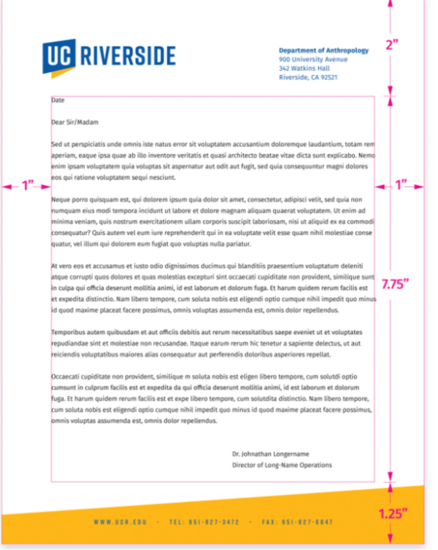Supporting Graduate Students' Academic and Professional Success

As you settle into the rhythm of the new academic year, you may find yourself receiving requests for letters of recommendation from former students, research assistants, or others who have worked under your purview. Especially if you have never written one before, you may find yourself looking for some tips and tricks. Here is a breakdown of what you may want to keep in mind when writing your letter of recommendation.
[Image Description: A sign with two blue arrows labeled "Accept" and "Reject" pointing in opposite directions]
Pictured: We're here to help you make the tough decisions!
Should I accept the request to write this LOR?
Although it may seem mean to refuse a request, there are situations in which refusing a request may be beneficial for both you and the student.
- You don’t know the person well enough to write a personal/compelling letter. If you receive a request from a student who took your 250-person lecture four years ago and you barely recognize their name, you may not be the best person to write their letter of recommendation. You may politely recommend that they ask a TA or professor whom they have worked with more recently, or more closely.
- You know the person, but their work would not result in a glowing recommendation from you. If you receive a request from a student whose work left something to be desired, you are most likely not the best person to write their letter of recommendation. This is not the time to berate the student and list reasons why their work was unsatisfactory, rather thank them for their request, politely decline, and if you can, provide a suggestion for who may be a better fit for their letter writing.
- The student did not give you enough time to write the letter. Sometimes, students are overwhelmed and may procrastinate or forget to ask you for a letter of recommendation. I personally have had students ask me for a letter of recommendation within a week of the due date. A general rule of thumb is 1-2 month notice for a letter of recommendation request, so if a student asks later you may politely deny the request. Sometimes, students may come to you at the last minute because another recommender who agreed to write a letter fell through. I tend to be a bit more lenient in those situations but it really is up to you and depends on your current availability.
- You know your upcoming month or two will be too busy for you to have time to write a thoughtful letter. Even if the student gives you plenty of notice, there may be personal or professional reasons why that timing does not work for you. If that is the case, you may politely decline and provide suggestions for who would be a good fit.
[Image Description: The word "content" written on a chalkboard and surrounded by drawings]
Pictured: The results of a very creative brainstorming session!
What should my letter of recommendation include?
Most letters of recommendation follow the same general format, making it easy for you to provide one that meets expectations.
- Greeting. Start the letter with “Dear Dr./Mr./Ms./Mx. XYZ”, or “To whom it may concern,” if you do not know the name of the person to whom it should be addressed.
- Introduce yourself and the student. In these few sentences, you should state the name of the person you are recommending, the position or opportunity for which you are recommending them, and how you are professionally connected to them. For example, “It is with pleasure that I recommend STUDENT for admission in UNIVERSITY’S XYZ MA/PhD program in FIELD. STUDENT was an exemplary student in my Introduction to FIELD course and Advanced Topic in FIELD course over the past two years.”
- Provide an overview of traits/skills that the student possesses that you think makes them a good match for the program/position. You will get into specifics later, but here you will provide a quick overview of reasons that you back this student. These can be personal traits (e.g., responsible, driven, passionate) or specific skills (e.g., knowledge of XYZ coding languages, mastery of XYZ lab techniques, high-quality writing skills).
- Get specific: provide at least one personal anecdote. If you have statistics backing up their skills, this is the place to put them (e.g., STUDENT received perfect scores on every assignment for which the class average was 80%, or STUDENT worked in my lab two days per week and produced XYZ number of successful trials). You also want to include something here that shows the personal characteristics you listed. Illustrative examples are always best. This can come from a particularly insightful comment they made during a class discussion or discussion post (with the student’s permission), or a time when they went above and beyond expectations for the class/lab. However you choose to demonstrate the trait/skill, be sure to be specific!
- Wrap it up. Provide a conclusion that summarizes your letter thus far and reemphasizes the traits/characteristics you want to drive home. Readers *may* be skimming these letters (which is why we keep them brief, as discussed in the next section), so while you don’t want to be redundant, it can be helpful to provide reminders of why you recommend this person as you are closing the letter.
- Sign it! Print it and provide a wet signature, then scan it back in to submit virtually (or if all else fails, sign a blank piece of paper, take a picture of it, insert the picture of the signature into the document, and make sure it looks seamless when you convert it to a PDF). Below your wet signature, provide your name typed, your position, and your contact information (email address and phone number).
[Image Description: A sample LOR written on UCR letterhead]
Pictured: Looking at a good example makes writing any type of document easier.
What should my letter of recommendation look like?
Letters of recommendation usually shouldn’t be submitted on a plain piece of paper, and luckily there are options to make your letter look more professional.
- Use UCR letterhead. UCR Letterhead is available at the following link: https://brand.ucr.edu/uc-riverside-stationery. There are options for different templates, so be sure to change the information to fit your department and contact information.
- Use a professional font. UCR’s letterhead comes with a recommended font, but if you choose to stray stick to fonts like Times New Roman, Calibri, Arial, Helvetica, etc. Do not use "quirky" fonts like Comic Sans or Chalkboard. Use a font size of 10, 12, or maybe 14. Do not go below 10 or above 14 as this affects readability.
- Submit it as a PDF. Do not submit your letter of recommendation as a Word document, unless specifically instructed to by the submission portal. You can also sign your document using Adobe’s secure sign feature if that is available to you in order to avoid having to print and give a wet signature.
- 1-2 pages max. Ideally, your letter of recommendation will be about one page. Some portals will even require a one page maximum. Depending on the position and the student, the letter may extend to a second page but should absolutely not go beyond that. Remember, the readers may be skimming so staying concise benefits you and the student.
Final tips!
- Proofread! Like all documents, please remember to proofread the letter of recommendation before you submit it. Although typos won't necessarily reflect poorly on the student as they didn’t write it, it does not reflect well on you.
- Submit the document EARLY. Do not be the reason a student’s grant proposal or grad school application is rejected before it is even read. Submission portals tend to get a lot of traffic on the day things are due. My rule of thumb has always been to submit the letter at least a day early.
Now that you have done your LOR research, go write some stellar letters of recommendation!


